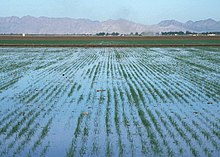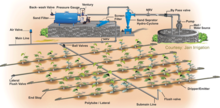IRRIGATION SYSTEM
Irrigation is the application of controlled amounts of water to plants at needed intervals. Irrigation helps to grow agricultural crops, maintain landscapes, and revegetate disturbed soils in dry areas and during periods of less than average rainfall.
Surface irrigation
Surface irrigation is the oldest form of irrigation and has been in use for thousands of years. In surface (furrow, flood, or level basin) irrigation systems, water moves across the surface of an agricultural lands, in order to wet it and infiltrate into the soil. Surface irrigation can be subdivided into furrow, borderstrip or basin irrigation. It is often called flood irrigation when the irrigation results in flooding or near flooding of the cultivated land. Historically, this has been the most common method of irrigating agricultural land and is still used in most parts of the world.
Where water levels from the irrigation source permit, the levels are controlled by dikes, usually plugged by soil. This is often seen in terraced rice fields (rice paddies), where the method is used to flood or control the level of water in each distinct field. In some cases, the water is pumped, or lifted by human or animal power to the level of the land. The water application efficiency of surface irrigation is typically lower than other forms of irrigation.
Surface irrigation is even used to water landscapes in certain areas, for example, in and around Phoenix, Arizona. The irrigated area is surrounded by a berm and the water is delivered according to a schedule set by a local irrigation district.
Micro-irrigation

Micro-irrigation, sometimes called localized irrigation, low volume irrigation, or trickle irrigation is a system where water is distributed under low pressure through a piped network, in a pre-determined pattern, and applied as a small discharge to each plant or adjacent to it. Traditional drip irrigation using individual emitters, subsurface drip irrigation (SDI), micro-spray or micro-sprinkler irrigation, and mini-bubbler irrigation all belong to this category of irrigation methods.
Drip irrigation
Drip (or micro) irrigation, also known as trickle irrigation, functions as its name suggests. In this system water falls drop by drop just at the position of roots. Water is delivered at or near the root zone of plants, drop by drop. This method can be the most water-efficient method of irrigation, if managed properly, evaporation and runoff are minimized. The field water efficiency of drip irrigation is typically in the range of 80 to 90 percent when managed correctly.
In modern agriculture, drip irrigation is often combined with plastic mulch, further reducing evaporation, and is also the means of delivery of fertilizer. The process is known as fertigation.
Sprinkler irrigation
In sprinkler or overhead irrigation, water is piped to one or more central locations within the field and distributed by overhead high-pressure sprinklers or guns. A system using sprinklers, sprays, or guns mounted overhead on permanently installed risers is often referred to as a solid-set irrigation system. Higher pressure sprinklers that rotate are called rotors and are driven by a ball drive, gear drive, or impact mechanism. Rotors can be designed to rotate in a full or partial circle. Guns are similar to rotors, except that they generally operate at very high pressures of 275 to 900 kPa (40 to 130 psi) and flows of 3 to 76 L/s (50 to 1200 US gal/min), usually with nozzle diameters in the range of 10 to 50 mm (0.5 to 1.9 in). Guns are used not only for irrigation, but also for industrial applications such as dust suppression and logging.
Center pivot
Center pivot irrigation is a form of sprinkler irrigation utilising several segments of pipe (usually galvanized steel or aluminium) joined together and supported by trusses, mounted on wheeled towers with sprinklers positioned along its length.[31] The system moves in a circular pattern and is fed with water from the pivot point at the center of the arc. These systems are found and used in all parts of the world and allow irrigation of all types of terrain. Newer systems have drop sprinkler heads as shown in the image that follows.
Irrigation by lateral move (side roll, wheel line, wheelmove)
A series of pipes, each with a wheel of about 1.5 m diameter permanently affixed to its midpoint, and sprinklers along its length, are coupled together. Water is supplied at one end using a large hose. After sufficient irrigation has been applied to one strip of the field, the hose is removed, the water drained from the system, and the assembly rolled either by hand or with a purpose-built mechanism, so that the sprinklers are moved to a different position across the field. The hose is reconnected. The process is repeated in a pattern until the whole field has been irrigated.
Lawn sprinkler systems
Hose-end sprinklers
 There are many types of hose-end sprinklers. Many of them are smaller versions of larger agricultural and landscape sprinklers, sized to work with a typical garden hose. Some have a spiked base allowing them to be temporarily stuck in the ground, while others have a sled base designed to be dragged while attached to the hose.
There are many types of hose-end sprinklers. Many of them are smaller versions of larger agricultural and landscape sprinklers, sized to work with a typical garden hose. Some have a spiked base allowing them to be temporarily stuck in the ground, while others have a sled base designed to be dragged while attached to the hose.Subirrigation
Subsurface textile irrigation
Subsurface Textile Irrigation (SSTI) is a technology designed specifically for subirrigation in all soil textures from desert sands to heavy clays. A typical subsurface textile irrigation system has an impermeable base layer (usually polyethylene or polypropylene), a drip line running along that base, a layer of geotextile on top of the drip line and, finally, a narrow impermeable layer on top of the geotextile (see diagram). Unlike standard drip irrigation, the spacing of emitters in the drip pipe is not critical as the geotextile moves the water along the fabric up to 2 m from the dripper. The impermeable layer effectively creates an artificial water table.






Comments
Post a Comment